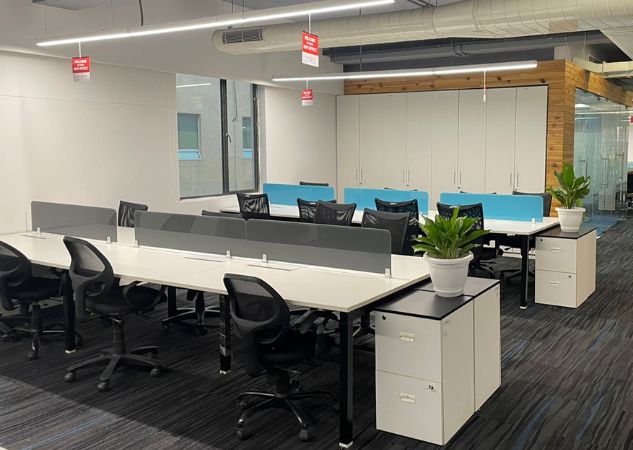Workplace automation is transforming how we work with greater speed and efficiency. This guide shows how to balance tech with emotional intelligence, creativity, and human connection.
💡 Are you looking for Coworking space in Gurgaon, Noida or Delhi? We are just a call away.
Call Now: 08999 828282
10 Practical Ways to Balance Workplace Automation with Human Connection
- Understand What Workplace Automation Means
- Identify Tasks That Are Ideal for Automation
- Use Automation to Support Human Work, Not Replace It
- Communicate the Purpose of Automation Clearly
- Train Your Team for a Digital-First Future
- Personalize Customer Experiences Using Automation
- Blend Emotional Intelligence with Automation
- Monitor and Improve Your Automation Systems
- Maintain Strong Human Connections
- Choose the Right Tools for Your Business
1. Understand What Workplace Automation Means
Workplace automation refers to using technology and machines to perform tasks that were previously done by people. This includes software, robots, and AI tools that handle data entry, customer service, scheduling, and more. As automation in the workforce grows, it’s important for businesses and employees to understand what can and cannot be automated. It’s not about replacing people—it’s about freeing them from repetitive tasks so they can focus on higher-value work.

2. Identify Tasks That Are Ideal for Automation
To get started with automation at the workplace, identify tasks that are time-consuming, repetitive, or prone to human error. Examples of automation in the workplace include payroll processing, sending reminder emails, and generating reports. These are perfect candidates for automation tools. When done right, this allows your team to work smarter, not harder, while maintaining quality and efficiency.
3. Use Automation to Support Human Work, Not Replace It
Successful digital workplace automation should assist your team, not replace them. Use tools that complement human skills—like chatbots for answering FAQs while your team handles complex queries. This keeps the human touch alive in customer interactions. Technology and automation in the workplace work best when they enhance decision-making, creativity, and empathy.
Also Read: How AI Is Transforming The Small Business Workplace
4. Communicate the Purpose of Automation Clearly
One of the biggest challenges with automation in the workforce is fear—employees worry about job loss. Clear communication can reduce this anxiety. Explain that automation is meant to eliminate boring or stressful tasks, not replace workers. When teams understand the “why” behind automation, they’re more likely to support and adopt it enthusiastically.
5. Train Your Team for a Digital-First Future
Introducing technology and automation in the workplace requires upskilling. Offer training programs to teach your staff how to use new tools effectively. This helps employees stay relevant and confident. Upskilling also shows your commitment to their growth, which strengthens trust and reduces resistance to change in a digitally evolving work environment.
6. Personalize Customer Experiences Using Automation
Automation can actually increase the human touch when used for personalization. For example, automated systems can track customer preferences and send targeted messages. This is one of the smarter examples of automation in the workplace, where digital tools create more meaningful interactions. Personalized service builds loyalty while saving time for your team.
7. Blend Emotional Intelligence with Automation
Automation doesn’t understand emotion, but your people do. Use your team’s emotional intelligence to handle sensitive situations, while automation manages the routine. For example, while an AI bot schedules appointments, a human can resolve customer complaints. This balance keeps the automation at the workplace smart and compassionate.
8. Monitor and Improve Your Automation Systems
Digital workplace automation is not a set-it-and-forget-it process. Track performance regularly and gather feedback from employees and customers. Are tasks being completed faster? Are people happy with the changes? Based on the data, improve your systems. Regular review ensures automation supports—not disrupts—your business goals and human values.
💡 Are you looking for Coworking space in Gurgaon, Noida or Delhi? We are just a call away.
Call Now: 08999 828282
9. Maintain Strong Human Connections
In an automated workplace, don’t forget to nurture relationships. Encourage team bonding, face-to-face meetings (in person or virtual), and regular check-ins. These small human touches keep your team connected. While automation in the workforce boosts productivity, human connection fosters creativity, motivation, and trust—things machines can’t replace.
10. Choose the Right Tools for Your Business
There’s no one-size-fits-all in workplace automation. Choose tools that match your business goals and team needs. Look for platforms that are user-friendly, flexible, and scalable. Consider real-life examples of automation in the workplace, like CRMs, HR software, or project management tools, and start small before expanding. The right tools ensure smooth adoption and real value.
Balancing workplace automation with the human touch is all about embracing smart tools while keeping people at the heart of your business. By combining technology with empathy, collaboration, and clear communication, companies can boost efficiency without losing what makes them unique. If you’re looking for a flexible coworking space that understands this balance, check out The Office Pass (TOP). TOP offers vibrant, community-driven workspaces designed for modern businesses. To learn more, call 08999 828282 and book a tour today!
FREQUENTLY ASKED QUESTIONS (FAQS):
Question: What is workplace automation?
Answer: Workplace automation is the use of technology to handle tasks that humans used to do manually. It helps businesses save time, reduce errors, and increase productivity by automating repetitive jobs like data entry, invoicing, or scheduling.
Question: How does automation at the workplace affect employees?
Answer: When done right, automation helps employees by taking over boring or repetitive tasks. This allows them to focus on more meaningful, creative, or strategic work. It can also reduce stress and improve job satisfaction.
Question: Can automation replace all jobs?
Answer: No, not all jobs can be replaced. While some tasks can be automated, skills like leadership, critical thinking, creativity, and empathy cannot be replaced by machines. Human involvement remains essential in most workplaces.
Question: What are examples of automation in the workplace?
Answer: Some common examples include chatbots for customer service, automated email replies, online scheduling tools, AI-based resume screening, and financial reporting software. These tools help speed up everyday tasks.
Question: Is workplace automation expensive to implement?
Answer: It depends on the tools you choose. Some automation platforms offer affordable plans for small businesses. Over time, automation can save more money by increasing efficiency and reducing manual errors.
Question: How do I start with digital workplace automation?
Answer: Begin by identifying repetitive tasks in your business. Choose simple tools like email marketing software or chatbots, and train your team to use them. Start small, monitor results, and scale gradually.
Question: Will automation reduce the need for human interaction?
Answer: Not necessarily. While machines handle routine tasks, humans are still needed for emotional intelligence, customer support, and team management. Automation should enhance, not reduce, human connection.
Question: How do I keep my team engaged during automation changes?
Answer: Involve them in the process, communicate clearly, and provide training. Show them how automation benefits their roles, and support them with upskilling opportunities. This helps reduce fear and builds trust.
Question: Are there risks in using automation in the workforce?
Answer: Yes. Poor implementation can lead to job stress, data errors, or unhappy customers. It’s important to plan carefully, monitor systems, and combine automation with human oversight for the best results.
Question: How does technology and automation in the workplace improve customer service?
Answer: Automation tools can respond quickly to basic customer queries, offer 24/7 service, and personalize communication. This improves customer experience while giving your team more time to handle complex issues.








